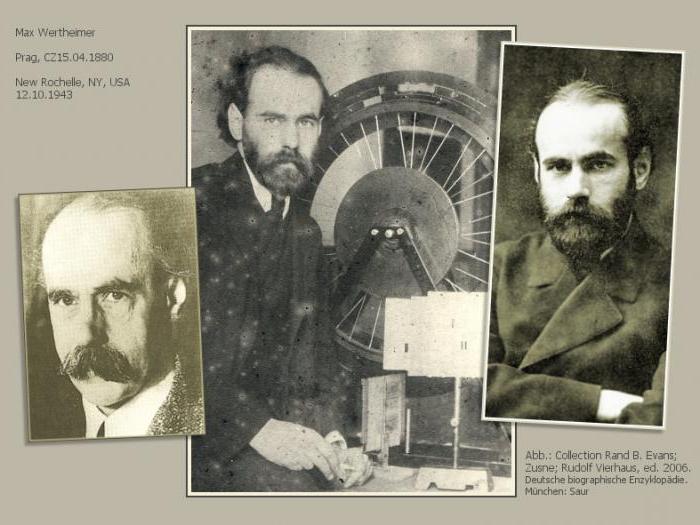The article will introduce you to the outstanding German psychologist, one of the founders of Gestalt psychology, Max Wertheimer. In his writings, special attention is paid to the problems of human dignity, personality psychology, and the theory of ethics, which he dealt with throughout his life.
Biography
Max Wertheimer (1880-1943), creator of gestalt psychology, was born in Prague. He was the second of two sons William and Rosa Zwicker Wertheimer. My father was the founder of a very successful and innovative business school called Handelsschule Wertheimer, and his mother was a professional pianist well-educated in culture, literature and art. From an early age, his mother taught him to play the piano, and as he got older, Max received violin lessons. In his teens, he composed chamber music and even wrote symphonies. It seemed to parents that he would connect his life with music and become a professional musician.

Thanks to art, Max Wertheimer established social relations, for example, with Albert Einstein. They often played chamber music and discussed philosophical and scientific problems. Friends and students of Max recalled how he liked to improvise on the piano, and then asked to guess what he describes with this musical composition - a person or an event. He also liked to use examples from the works of various composers in his lectures and works to demonstrate the concept of structure.
Acquaintance with the writings of Spinoza
Wertheimer got acquainted with the social and philosophical thought of his maternal grandfather Jacob Zwicker, who was so pleased with the maturity of his grandson that on his tenth birthday he presented him with some of Spinoza's works. The full absorption of Max Wertheimer as a book donated by his grandfather led his parents to restrict reading. This did not stop Spinoza from reading secretly, taking advantage of the kindness of the maid, who was hiding the book from her parents in her chest. Spinoza was not something coming; he influenced Wertheimer for life.
Max Universities
Wertheimer, having graduated from high school (at the age of 18), could not decide which specialization to choose. Nevertheless, he chose the Faculty of Law of the University of Prague. He studied law and law. By the time he graduated, he was more interested in the philosophy of law than practice. He did not like that the trials were not looking for the truth, but were more interested in defense and prosecution. He was also interested in ways to achieve truth, and this made him work in the psychology of evidence.
In 1901, Max continued his studies at the University of Berlin, where he studied psychology and conducted research with Karl Stumpf and Friedrich Schumann. But his range of interests was broader than the main subject of study, so he also includes history, music, art and physiology in the curriculum. In 1903, he studied at the University of Würzburg, with Oswald Külpe, and received a Ph.D. The thesis was devoted to detecting the guilt of a criminal during the investigation by the method of associative connection of words.
Doctoral studies
His doctoral research included the invention of lie detectors, which he used as an objective way to study evidence. Another aspect of his work was the collocation method, which he created before C.J. Jung developed it as a diagnostic method.
Since Max Wertheimer was financially independent, he did not need to occupy any academic position, and he could devote himself to independent research in Prague, Berlin and Vienna. He continued work related to the reliability of testimonies, and also at the neuropsychiatric clinic of the University of Vienna he worked with medical history of patients with speech impairment and those who had impaired reading, with damage to various parts of the left hemisphere cortex. He developed new diagnostic methods that showed that speech impairment is associated with a loss of ability to perceive ambiguous and complex visual structures. This work is the link between Gestalt psychology and the theory of neurologists Ademar Gelb and Kurt Goldstein.
Early Gestalt Theories
Working in Vienna, Wertheimer formulates ideas that have become important components of Gestalt psychology. What is gestalt psychology? This is a section of psychology that focuses on the issues of explaining the perception and thinking of a person, and the key is how a person perceives information.
It seemed to Max Wertheimer that psychology was divorced from the concrete realities of everyday life: problems in the center of academic psychology had little resemblance to real human behavior. According to Wertheimer, it was necessary to develop methods that would meet strict scientific standards.
Witness Methods
Thanks to ongoing research, Max Wertheimer has developed in detail methods for determining the authenticity of testimony:
- The method of association is the test subject's response to the proposed words. He must answer with the word that comes to his mind, as an association to the proposal.
- The method of reproduction is to use a text to remember, which contains information similar to hidden facts, similar to hidden facts and not having anything to do with hidden facts. After a while, the subject will make mistakes when reproducing the text.
- The method of associative questions. The study is based on a special list of leading questions. In the process of finding answers to them, there are those that will lead to a solution to the problem.
- Method of perception . It is based on the recognition of the type of person depending on their representative systems: visual, audio, kinesthetic and digital. Next, work with a person in the vein of his representative system.
- The distraction method includes many options, including deception, shock, an excessive flow of distracting information.
Experiments and Interpretations
Wertheimer in his studies constantly searched for examples from the field of perception. So, watching how the flashing lights at the station created an illusion of movement or Christmas garlands of lights that seem to be “running” around the trees, he thought of an optical phenomenon that turned out to be suitable in his work. To do this, he bought a toy strobe - a rotating drum with slots for viewing and pictures inside, and conducted an experiment, replacing the strips of paper on which he drew a series of lines for the pictures in the toy.
The results were as expected: changing the time interval between the exposure of the lines, he found that he could see one line after another, two lines standing next to each other, or a line moving from one position to another. This "movement" became known as the phenomenon of the phi phenomenon and was the basis of gestalt psychology. This phenomenon is a phi phenomenon that is used in cinematography to create movies. On the screen, the viewer sees what is not really what he sees. This can be called an illusion. Wertheimer explained that the viewer sees the effect of the "whole event", but not the sum of the components. Similarly with a running garland of lights. The observer sees the movement, despite the fact that only one light bulb shines in a row of the same light bulbs.
The work of three psychologists
Max Wertheimer and his two assistants: Wolfgang Köhler and Kurt Koffka, using their findings and research, formed a new Gestalt school, making sure that the segmented approach of most psychologists to the study of human behavior was insufficient. As a result of experimental research, Wertheimer's article "Experimental research in the perception of movement."
The First World War interrupted the collaboration of gestalt psychologists. Only after its completion did they continue their further research. Koffka returned to Frankfurt, and Köhler became director of the Psychological Institute at the University of Berlin, where Wertheimer already worked. Using the abandoned rooms of the Imperial Palace, they founded the currently-known graduate school, in tandem with a journal called Psychological Research.
Productive thinking
Before World War II, Wertheimer with his family leaves for the States. There he continues to conduct research to solve problems or, as he preferred to call it, “productive thinking”. Max Wertheimer maintained contact with Koffka and Köhler, whose earlier work with insight on chimpanzees was similar. He continued research in the field of human thinking. A typical example of this productive thinking is a child trying to solve a problem with a geometric figure - creating a parallelogram area. Suddenly, the child takes the scissors and cuts the triangle along the line of height from the top of the triangle, turns it and attaches it to the other side, forming a parallelogram. Or, working with puzzles, lays them out in the right places.

Wertheimer called this type of training “productive” in order to distinguish it from “reproductive” thinking, simple associative or trial and erroneous learning, in which there was no understanding. He considered true human understanding as a transition from a situation that is meaningless or incomprehensible to one in which the meaning is clear. Such a transition is more than just creating new connections; it involves structuring information in a new way, forming a new gestalt.
The work of Productive Thinking by Max Wertheimer, in which many of his ideas were discussed, was published posthumously in 1945.
Heritage
Gestalt psychology of Max Wertheimer was radically different from the psychology of Wilhelm Wundt, who sought to understand the human mind by identifying the constituent parts of the human mind as well as the chemical composition that can be decomposed into elements. Sigmund Freud’s sophisticated approach to psychopathology was proposed by an alternative method described by Max Wertheimer. The contribution to the psychology of Wetrheimer and his colleagues is confirmed by acquaintance with the names of their students in the literature of psychology, including Kurt Levin, Rudolf Arnheim, Wolfgang Metzger, Bluma Zeigarnik, Karl Danker, Hertha Kopfermann and Kurt Gottschaldt.
Max Wertheimer’s books are currently used by students, doctors, and psychologists. These include:
- "Experimental studies of motion perception."
- "The laws of organization in perceptual forms."
- "Gestalt Theory."
- Productive Thinking.
"The incredible complexity of human thought is connected with something more than the sum of its parts, the something in which the parts and the whole are connected to each other," said Max Wertheimer.